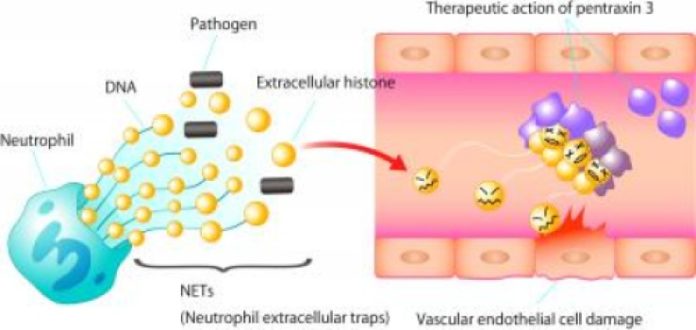
A University of Tokyo research group has discovered that pentatraxin 3 (PTX3), a protein that helps the innate immune system target invaders such as bacteria and viruses, can reduce mortality of mice suffering from sepsis. This discovery may lead to a therapy for sepsis, a major cause of death in developed countries that is fatal in one in four cases.
Professor Takao Hamakubo’s group at the Department of Quantitative Biology and Medicine, Research Center for Advanced Science and Technology (RCAST), have shown that PTX3 forms strong bonds with histones and partially unfolds, leading to a disordered coaggregation of histone and PTX3 and protecting human endothelial cells from damage. Further, mice treated with PTX3 recovered from sepsis, showing that treatment with PTX3 is a possible therapy not only for this condition, but also for ‘sterile’ sepsis induced by trauma, burn, ischemia, or hemorrhage, which also result in inflammation.
Histones are small proteins around which DNA is wound up in chromosomes, but once they are released into the extracellular plasma, they are toxic to the endothelial cells that line the blood and lymph vessels of the circulatory system. They also trigger inflammation, the innate immune system’s standard defensive response to infection. The team had reported previously in 2012 that extracellular histones bind to PTX3 in plasma from septic patients, which led to the hypothesis of a protective role of PTX3 in sepsis against extracellular histones.
“PTX3 interacts with many proteins of foreign origin or the body’s own inflammation-related proteins,” explains Professor Hamakubo. “Thus PTX3 is recognized as the soluble arm of a pattern recognition receptor, an essential part of innate immune system that recognizes pathogens. We observed extraordinarily rapid and tight interaction with histone, which we recognized as coaggregation after a variety of experiments. To our knowledge, this is the first report of coaggregation between different proteins that is protective to the host. We expect our findings lead to a novel understanding of protein interaction and that they will benefit people who are suffering from severe illness.”
Story Source:
The above story is based on materials provided by University of Tokyo. Note: Materials may be edited for content and length.
Journal Reference:
- K. Daigo, M. Nakakido, R. Ohashi, R. Fukuda, K. Matsubara, T. Minami, N. Yamaguchi, K. Inoue, S. Jiang, M. Naito, K. Tsumoto, T. Hamakubo. Protective effect of the long pentraxin PTX3 against histone-mediated endothelial cell cytotoxicity in sepsis. Science Signaling, 2014; 7 (343): ra88 DOI: 10.1126/scisignal.2005522
